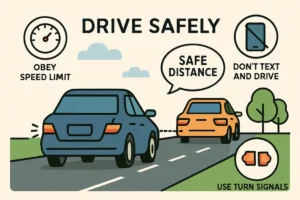The saying “along for the ride” isn’t just something people toss around casually – it reflects a deeper mindset. It’s about how we sometimes move through events in life without taking the wheel, and instead, we ride along with whatever happens. I’ve felt this during certain casual outings with friends, where I had no plan, no strong opinion – I was just in the passenger’s seat, going wherever the day took us. This phrase fits so many contexts – whether it’s a spontaneous road trip or a life-changing decision someone else made for you. Understanding how people use this idiom in speech, literature, and media helps you recognize it instantly, and, honestly, use it with natural ease.
In writing this article, I wanted to explore not just the meaning, but the roots of the phrase. It’s one of those idioms that shows up everywhere – from pop culture references to deep personal stories. The interesting thing is that being “along for the ride” doesn’t always mean you have no choice – sometimes it’s a conscious decision to let go and experience something fully. Other times, there’s a lack of control, and you’re just being pulled along. In either case, knowing how to recognize this phrase in different real-world situations expands your understanding of the language. It’s one of those expressions that can unlock a better feel for conversational English and show you how flexible and rich everyday phrases can be.
Definition and Literal vs. Figurative Meaning
Understanding along for the ride means grasping both literal and figurative use.
- Literal sense: You’re physically riding along – maybe in a car or on a bike.
- Figurative sense: You participate without leading – perhaps you’re observing or going with the group.
Synonyms and Related Expressions
| Phrase | Meaning |
| Tag along | Join someone, often casually |
| Ride shotgun | Sit in the front passenger seat (car slang) |
| Go with the flow | Accept events rather than control them |
| In the passenger seat | Metaphoric for non-leadership |
These expressions share a vibe with Along for the Ride, but each has its nuance.
Etymology and Historical Origins
Idioms evolve, and along for the ride is no exception.
- First recorded usage: Found in mid-20th-century spoken English, linked to car culture.
- Spread through pop culture: By the 1960s, movies and songs cemented it.
- Shift over time: Once literal, it now embraces broader life contexts.
These shifts map a journey from physical travel to one of mindset and observation.
Real-World Examples in Everyday Life
Social Situations
Often we use this idiom to describe family trips or nights out:
“I didn’t plan the movie night – I’m just along for the ride.”
Workplace Usage
In meetings or projects:
“I’m along for the ride on this project – I’ve no decision-making power.”
This phrase can highlight a passive role without judgment.
Personality Types
The phrase ties closely to passive or adaptive personalities. Some people naturally avoid control and prefer letting others take the lead.
Media, Film, and Pop Culture References
Pop culture loves this phrase – it’s relatable, catchy, and concise.
Movies & TV
- Netflix’s “Along for the Ride” (2022) features a young adult romance wrapped around biking and self-expression.
- Countless reality shows frame characters as “along for the ride” while major drama unfolds.
Music & Literature
Songs and novels use the phrase to illustrate a supportive yet subdued role:
“I was along for the ride / Watched you build your life,” (example lyric).
These snippets highlight loyalty, distance, or even sidekick status.
Global and Cultural Perspectives
How do other languages express being a tagalong?
| Language | Equivalent Phrase | Literal Translation |
| Spanish | “A merced del viaje” | At the mercy of the ride |
| French | “Simple accompagnateur” | Simple accompanist |
| German | “Begleiter auf der Fahrt” | Companion on the trip |
| Japanese | “御前で付き合わせていただく” | I humbly accompany you |
Some idioms barely translate but still convey similar nuances of passivity or accompaniment.
Common Misinterpretations and Misuse
Even idioms can be misused or misunderstood.
- Negative vs. neutral: Saying someone’s along for the ride doesn’t always mean lazy – it might mean supportive.
- Professional context: Overuse in workplace emails can sound dismissive.
- Context matters: Tone and setting decide whether it’s playful or passive-aggressive.
Related Idioms and How They Differ
We’ve touched on a few synonyms already. Let’s deepen the comparison:
- Go with the flow: More adaptability, less passivity.
- Tag along: Suggests joining, not necessarily staying quiet.
- Ride shotgun: Literal passenger seat; tuning in on directions, contrast to metaphorical use.
These idioms might seem similar, but their tone and intent vary.
Practical Tips for Using This Idiom Naturally
When it works best
- Casual conversations with friends
- Storytelling (texting or writing)
- Relatable personal narratives
When to avoid
- Formal writing or professional communication
- When your role is decisive, wouldn’t make sense to say you’re along for the ride
Dos and Don’ts
Do
- Use for observation or lack of control
- Embed in storytelling
Don’t
- Use in high-stakes settings
- Confused tone – keep it light
Case Study
Imagine two friends:
- Mike planned a road trip.
- Sara just showed up and said, “I’ll be along for the ride.”
During a detour, Mike took charge. Sara enjoyed the journey. Later, she joked, “I never drove – but I had the best time being along for the ride.” This moment captured the phrase’s simple joy and casual nature.
Conclusion:
The idiom “along for the ride” is more than a casual phrase – it’s a reflection of how people engage with life, relationships, decisions, and even emotions. Whether you’re literally in a passenger seat or metaphorically letting someone else steer, this idiom conveys an attitude of observation, support, or sometimes, detachment. Its versatility makes it valuable in both spoken and written English, especially in informal or narrative contexts.
Understanding its origin, contextual meanings, and cultural nuances empowers you to use it more effectively. Idioms like this bring color to conversation and help you sound more fluent, relatable, and expressive. The next time you’re describing a situation where you’re not in control but still present, “along for the ride” may be the perfect fit.
FAQs:
What does “along for the ride” mean?
It typically refers to someone participating in an activity or event without playing an active or leading role. It can be literal (as in physically being a passenger) or figurative (being involved in something without influencing its direction).
Is “along for the ride” a negative phrase?
Not always. While it can imply passivity or lack of involvement, it can also reflect relaxed participation or support. Tone and context determine whether it’s positive, neutral, or negative.
Can I use “along for the ride” in professional settings?
It depends. In informal workplace conversations or casual team meetings, it might be fine. But in formal writing or high-level communication, it’s better to say “passively involved” or “not in a decision-making role.”
How is “along for the ride” different from “go with the flow”?
“Along for the ride” often implies no control or input, while “go with the flow” suggests flexibility and willingness to adapt. The former leans passive, the latter active.
Are there equivalents of this idiom in other languages?
Yes, many cultures have expressions that convey similar meanings. For example:
- Spanish: a merced del viaje (“at the mercy of the ride”)
- French: simple accompagnateur (“simple accompanist”)
- German: Begleiter auf der Fahrt (“companion on the ride”)











